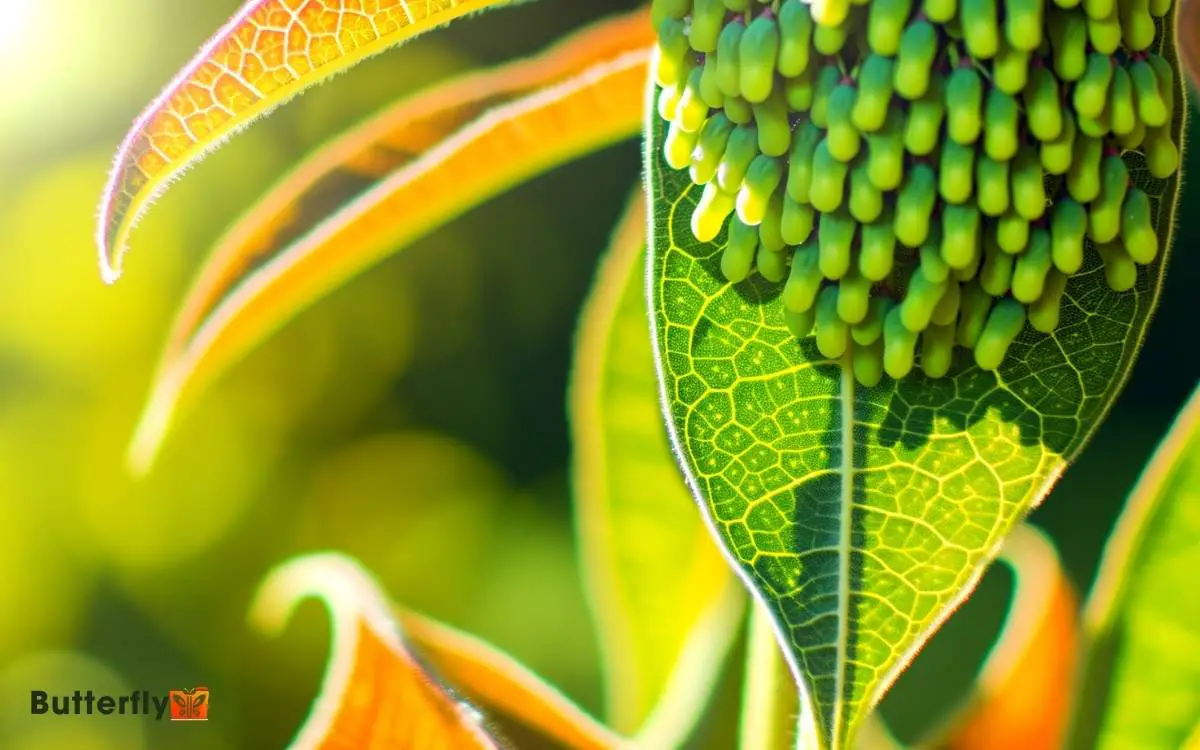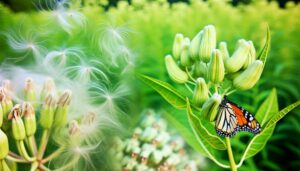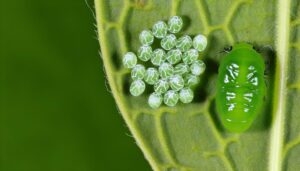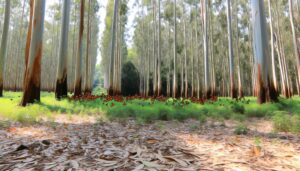How to Find Monarch Butterfly Eggs? Explore Helpful Guides!
To find Monarch butterfly eggs, check milkweed plants like common milkweed and swamp milkweed. Look in sunny areas with thriving milkweed from late spring to early summer.
Use a hand lens to spot cream-colored, oval eggs with vertical ridges on the underside of leaves. Observe Monarchs’ orange and black wings fluttering around milkweed as an indicator.
Avoid mistaking other insect eggs by noting the egg color and ridges. Document your findings meticulously, including date, time, and location.
Monitoring plant health and promoting native flora will support your conservation efforts. There’s more you can discover about this fascinating process.

Key Takeaways
Understanding Monarch Habitats
To understand monarch habitats, you’ll need to focus on the specific types of milkweed plants that monarch butterflies exclusively use for laying their eggs.
Monarchs exhibit strict oviposition behavior, meaning they only lay eggs on milkweed. These plants belong to the Asclepias genus, which provides essential nutrients and toxins that protect larvae from predators.
Observing these plants, you’ll notice monarchs prefer both common milkweed (Asclepias syriaca) and swamp milkweed (Asclepias incarnata).
You should methodically survey areas with abundant sunlight, as milkweed thrives in well-lit conditions. Pay attention to plant height and leaf condition; healthy, robust plants are more attractive to monarchs.
Document any variations in leaf texture and color, as these factors can influence egg-laying preferences.
Identifying Milkweed Varieties
While exploring monarch habitats, you’ll need to recognize the various milkweed varieties that these butterflies rely on for egg-laying. Milkweed varieties exhibit distinct characteristics, influencing monarch preferences.
| Milkweed Variety | Key Characteristics |
|---|---|
| Common Milkweed | Broad leaves, pink clusters of flowers |
| Swamp Milkweed | Narrow leaves, pink blooms, found in wet areas |
| Butterfly Weed | Bright orange flowers, narrow lance-shaped leaves |
Recognizing these varieties ensures you’re searching in the right spots for monarch eggs. Accurate identification is important for successful egg discovery.
Best Times to Search
To optimize your search for Monarch butterfly eggs, pay close attention to weather conditions such as mild temperatures and low wind speeds, which favor egg-laying.
You’ll also find it beneficial to target the peak mating season, typically from late spring to early summer.
Ideal Weather Conditions
For the best chances of finding monarch butterfly eggs, search during warm, sunny days with temperatures between 70°F and 85°F. Monarchs prefer laying their eggs in such conditions as it optimizes egg survival and caterpillar growth.
Check milkweed plants, the primary host for monarch eggs, during late morning to early afternoon when temperatures peak, and butterflies are most active.
Avoid overcast or rainy days; monarchs are less likely to lay eggs under these conditions. Monitor wind conditions, as strong winds can deter monarch activity.
Consistent weather observations are essential. Document temperature, humidity, and sunlight exposure to refine your search strategy.
Peak Mating Season
Understanding the peak mating season is essential for timing your search for monarch butterfly eggs. Monarchs primarily mate during late spring and early summer, from late April to early July. During this period, females lay eggs on milkweed plants, their larvae’s sole food source.
To maximize your chances, conduct your search in the morning when butterflies are most active. Focus on inspecting the undersides of milkweed leaves, where eggs are typically deposited. Note that egg-laying can vary based on regional climates, so adjust your timing accordingly.
Tracking local monarch activity through citizen science platforms can provide real-time insights. By aligning your search with the peak mating season, you’ll increase the likelihood of discovering monarch eggs.
Tools You’ll Need
You’ll need a few specific tools to accurately locate and identify monarch butterfly eggs. Begin by equipping yourself with the right instruments to guarantee precision and efficiency.
Here’s a list of essential items:
- Hand lens: Magnification is essential for observing the minute details of the eggs.
- Field notebook and pen: Document your findings meticulously, noting the date, location, and any observational details.
- Small container: For safely collecting samples without causing harm.
- Milkweed identification guide: Monarch eggs are laid on milkweed plants; knowing the exact species is crucial.
Utilizing these tools will enable you to methodically search and record your observations. Focus on the undersides of milkweed leaves where eggs are typically deposited, enhancing your ability to identify and monitor these delicate structures.
Spotting Monarch Butterflies
To effectively spot Monarch butterflies, you’ll need to identify their distinctive orange and black wing patterns.
Observe their behavior closely; Monarchs often glide gracefully and exhibit a slow, deliberate flight. Pay attention to their preference for milkweed plants, as these are vital for their lifecycle.
Identifying Monarch Characteristics
Spotting Monarch butterflies involves observing their distinct orange and black wing patterns, which feature black veins and white spots along the edges.
You should note the following characteristics for precise identification:
- Wing Shape: Monarchs have forewings that are angular with a curved outer edge.
- Body Color: Their bodies are black with small white dots.
- Size: Monarchs typically have a wingspan ranging from 3.5 to 4 inches.
- Sexual Dimorphism: Males have two black spots on their hindwings, which females lack.
Carefully observe these features when identifying Monarchs. This detailed approach ensures accurate identification, vital for locating Monarch butterfly eggs.
Understanding these characteristics will greatly enhance your ability to spot and study Monarchs effectively.
Recognizing Butterfly Behavior
Having identified the distinct characteristics of Monarch butterflies, you should now focus on their specific behaviors to enhance your ability to locate them in their natural habitat.
Monarch butterflies exhibit certain behaviors that can clue you in on their presence. Look for fluttering movements around milkweed plants, as these are their primary host plants.
Females often display meticulous egg-laying behavior, frequently hovering over leaves and tapping them with their feet to inspect suitability.
Additionally, observe their flight patterns; Monarchs have a distinctive, gliding movement interspersed with rapid wing flaps. Early morning and late afternoon are prime times for activity.
Inspecting Milkweed Leaves
Begin by carefully turning over each milkweed leaf, as monarch butterfly eggs are usually laid on the underside.
Pay close attention to the following characteristics:
- Leaf Shape and Health: Look for healthy, green leaves; monarchs prefer them for laying eggs.
- Size and Texture: Monarch eggs are about the size of a pinhead and have a smooth texture.
- Location on the Plant: Eggs are often found on the lower, older leaves but can also be on newer growth.
- Presence of Holes or Damage: This might indicate previous monarch activity, increasing the likelihood of finding eggs.
Use a magnifying glass to enhance visibility. Observe meticulously, as the small size of the eggs requires careful inspection. This methodical approach ensures you won’t overlook any potential monarch offspring.
Recognizing Monarch Eggs
How can you reliably identify monarch eggs amidst the myriad of other small objects on milkweed plants?
First, focus on the color and shape. Monarch eggs are typically creamy white and oval, about the size of a pinhead. Look for them singly, often on the underside of milkweed leaves.
Use a magnifying glass to observe the significant ridges running vertically along the egg’s surface these are important identifiers.
Examine the positioning; monarchs usually lay eggs on the top third of the plant.
To conclude, check for the presence of a single egg per leaf, as monarchs rarely lay multiple eggs on the same leaf. By combining these observations, you’ll enhance your ability to distinguish monarch eggs with confidence.
Avoiding Common Mistakes
To guarantee accurate identification, it’s crucial to avoid mistaking aphid eggs or other insect larvae for monarch eggs by meticulously examining the egg’s color, shape, and surface ridges. Monarch eggs are cream-colored, oval-shaped, and have distinct vertical ridges.
Always use a magnifying glass for enhanced observation and follow these guidelines:
- Examine Color: Monarch eggs are cream to pale yellow, unlike aphid eggs, which are often yellow or green.
- Check Shape: Monarch eggs are more oval, while other insect eggs may be round or irregular.
- Inspect Surface: Monarch eggs have fine vertical ridges; other eggs might be smooth or differently textured.
- Location Matters: Monarchs lay their eggs singly on the underside of milkweed leaves.
Adhering to these details ensures accurate identification.
Documenting Your Findings
Accurately documenting your findings involves noting the date, time, location, and specific plant on which each monarch egg is found. Use a systematic approach to guarantee detailed records. Start by recording the exact date and time of your observation.
Note the precise location using GPS coordinates if possible. Identify the plant species, focusing on milkweed, where monarchs typically lay eggs. Keep a field journal or digital log.
The table below helps organize your data:
| Date | Time | Location | Plant Species |
|---|---|---|---|
| 2023-05-15 | 09:30 | 35.6895° N, 139.6917° E | Asclepias Syriaca |
| 2023-05-16 | 10:00 | 34.0522° N, 118.2437° W | Asclepias Incarnata |
| 2023-05-17 | 11:15 | 40.7128° N, 74.0060° W | Asclepias Tuberosa |
| 2023-05-18 | 12:45 | 51.5074° N, 0.1278° W | Asclepias Speciosa |
This methodical documentation will enhance your understanding of monarch egg-laying patterns.
Conservation and Care Tips
To support monarch butterfly conservation, focus on protecting natural habitats and ensuring the proliferation of milkweed, their primary host plant.
Observe safe handling practices to avoid damaging eggs or larvae during your studies.
Protecting Natural Habitats
Preserving natural habitats is crucial for sustaining monarch butterfly populations, and detailed observation of plant species can greatly aid in this effort.
You should conduct regular surveys to identify and document native flora. This methodical approach helps in recognizing critical habitats that necessitate conservation.
By maintaining biodiversity, you support the ecological balance necessary for monarch survival.
- Monitor plant health: Regularly check for signs of disease or pest infestation.
- Avoid chemical pesticides: Use natural alternatives to protect plants and the butterflies.
- Promote native flora: Make sure that local plant species are thriving.
- Reduce habitat fragmentation: Maintain continuous, connected habitats to facilitate butterfly migration.
Implement these measures to create a supportive environment for monarch butterflies.
Supporting Milkweed Growth
While maintaining natural habitats is essential, you should also focus on supporting milkweed growth, as it’s the sole host plant for monarch butterfly larvae.
To enhance milkweed proliferation, select species native to your region, ensuring ecological compatibility. Plant milkweed in areas with full sunlight, as it thrives in well-drained soils.
Regularly inspect for pests and diseases, using organic solutions to mitigate harm. Water young plants thoroughly, but avoid waterlogging. Mulching around the base conserves soil moisture and suppresses weeds.
Rotate planting locations annually to prevent soil depletion. By fostering healthy milkweed growth, you’ll provide essential resources for monarchs during their breeding cycle, contributing to their conservation and enhancing your chances of finding monarch butterfly eggs.
Safe Handling Practices
When handling monarch butterfly eggs, it is essential to use gentle tools like a soft brush or tweezers to avoid damaging the delicate structures. Handle each egg with precision to guarantee their viability.
Always work in a clean environment to prevent contamination and possible pathogen transmission.
- Use sterilized tools. This minimizes the risk of introducing harmful microorganisms.
- Avoid direct contact with the eggs as oils and contaminants on your skin can damage them.
- Inspect eggs regularly to check for mold or desiccation to ensure their best health.
- Maintain appropriate humidity by using a damp paper towel to mimic natural moisture levels.
Conclusion
In locating monarch butterfly eggs, you might worry that your efforts will be fruitless. However, with a methodical approach understanding monarch habitats, identifying milkweed, and searching at ideal times you’ll increase your chances greatly.
Equip yourself with the right tools, make detailed observations, and avoid common mistakes. By documenting your findings, you’ll contribute to valuable conservation efforts.
Remember, each egg you find supports the survival of this magnificent species, making your diligent search worthwhile.






